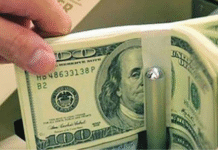New Age
HM Murtuza | Jul 02,2020
 The country’s remittance earnings hit record $18.21 billion in the just concluded fiscal year 2019-20 with the country’s foreign exchange reserve exceeding the $36 billion-mark for the first time on Thursday.
The country’s remittance earnings hit record $18.21 billion in the just concluded fiscal year 2019-20 with the country’s foreign exchange reserve exceeding the $36 billion-mark for the first time on Thursday.
The inflow of remittance in FY20 is 10.88 per cent or $1.79 billion higher than the $16.52-billion remittance received in the previous fiscal year.
A sharp increase in remittance inflow in June after five dismal months helped the country’s forex reserve to reach a fresh all-time high of $36.01 billion, an official of the Bangladesh Bank told New Age on Thursday.
June, the last month of FY20, witnessed a 33.97-per cent or Tk $464.8 million increase in remittance earnings.
As a result, remittance inflow in June also hit an all-time high of $1.83 billion in June this year. Earlier, the highest single-month remittance earnings were $1.75 billion in May last year.
Speaking about the record remittance inflow in June, Policy Research Institute executive director Ahsan H Mansur told New Age, ‘The record inflow of remittance in June was not normal considering the global economic state and the situation in the migrate workers’ job destinations.’
‘It might be the joblessness of expatriates that prompted them to send all their savings before they come to the country,’ he said.
Apart from June 2020, the country’s remittance inflow witnessed an upward trend in the first half of the fiscal year as the government started issuing 2 per cent incentive against inward remittances on easy terms, prompting expatriates to remit money through the formal channel, officials of the central bank said.
The surge slowed down in January and February as many countries including the migrant workers’ destinations went into prolonged lockdown to contain the spread of coronavirus, hitting economies across the globe badly.
As a result, remittance inflow witnessed a fall in March, April and May and turned around strongly in June.
With the country’s foreign exchange reserve reaching $36.01 billion on Thursday, it took only one month to increase reserve by $2 billion.
The country’s reserve reached the $34 billion and $35 billion marks on June 3 and June 24 this year respectively.
The previous highest reserve was recorded on September 5, 2017 and the amount was $33.68 billion.
Speaking about piling up of reserve amid the stagnant economy, Ahsan said that the reserve surged due mainly to a fall in imports and it was a reflection of weak economic state of the country.
In the first eleven months (July-May) of FY20, the country’s import payments dropped by 10.81 per cent to $46.24 billion from $51.85 billion in the same period of FY19.
Unless the coronavirus situation is tackled effectively, it would be difficult to revive the country’s economy, Ahsan said.
He, however, said that the central bank should utilise the scope for building up reserve and the reserve would support the foreign investors to gain confidence while considering Bangladesh as an investment destination.
Besides, the central bank should not allow appreciation of the taka against the dollar, he said, adding, ‘Otherwise, exporters would lose competitiveness on the global market in future.’
If the country manages to accumulate a reserve that would be sufficient for 10-12 months by taking the scope, it would be helpful for the businesses also, he said.
BB officials also said that receipt of foreign credit by the government in recent times was another reason for the spike in the country’s forex reserve.









